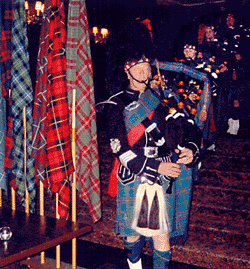History of the
Kirkin' o' the Tartan Service
Note: We contacted the historian of the New York Avenue Presbyterian Church to research the origins of the Kirkin' service in America. We also researched contemporaneous sources. While there are many versions on the internet, we believe this brief outline to be accurate.
Worshippers gathered over 65 years ago on Sunday evening, April 27, 1941, in Washington, D.C., at a special service led by Peter Marshall, famed pastor (1935 - 1949) of the New York Avenue Presbyterian Church. Rev. Marshall later also served as Chaplain to the United States Senate (1947 - 1949). Attended by members of the St. Andrews Society of Washington, D.C., the 1941 service had Scottish airs as a prelude to the service.
Designed to raise funds, this Kirkin’ service sought to aid Scottish churches during the early days of World War II, as well as the British war effort, by providing a mobile kitchen, according to the church bulletin. This initial, simple Kirkin’ service later evolved into what is today the Kirkin’ o’ the Tartan held in many locations across America. Since 1954, an annual Kirkin’ o' the Tartan has been held at the National Cathedral in the nation’s capital.
A remembrance of early Scottish Presbyterianism, Kirkin’ o’ the Tartan worship services have spread across America. Our first Kirkin’ was held in Montreat in April 1982. The next year, the Montreat Kirkin' service was moved to the Sunday of Memorial Weekend. We will hold our 26th annual Kirkin’ o’ the Tartan on May 27, 2007, in Montreat.
Scotland in the mid-18th century saw the English parliament and monarchy (The Disarming Act, 1746 - 1782) banning weapons, as well as the wearing of tartan or kilts by Highland clansmen (effective August 1747). A latter-day legend has it that clansmen would carry small pieces of the banned tartan cloth to the Church (Kirk) and the clergymen would slip a blessing into the service.
The Holy Scriptures were the responsibility of The Beadle, a lay person in the Scottish Kirk. The Beadle brought the Bible into the Kirk for the worship service.
In early history, clans were simply a gathering of peoples for their protection and for economic, political and social support. They were not necessarily related by blood.
Specific tartans developed simply because each area liked to weave a certain design using local herb dyes.
Why then do we celebrate clans and tartans? It is because the clansmen
demonstrated true brotherhood and the clan was the family. The tartan is a symbol of this love and togetherness.
In our Kirkin’ service, we remember ancient times, as well as past and present kith and kin, while asking God’s help and blessings in the future.
|




